Republic of Estonia
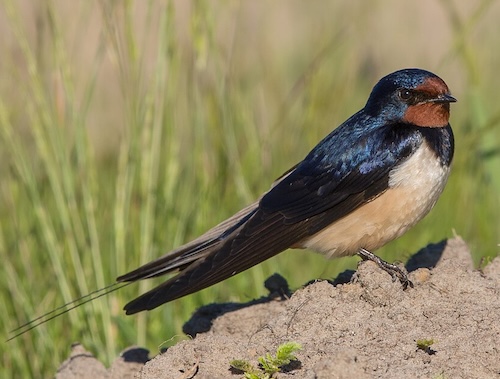
Estonia is a Baltic Country in Northern Europe. It shares land borders with Latvia to the south and Russia to the East. To the north and west is the Gulf of Finland. Estonia’s territory includes the mainland and many islands. The total number of Estonian islands, including those in internal waters, is 2,355, of which 2,222 are in the Baltic Sea. The largest islands are Saaremaa, Hiiumaa and Muhu. The country covers a total area of 45,335 km2 (17,504 square miles). It is located on the northwestern part of the East European Platform, bordering the Fennoscandian Shield. The capital Tallinn with approaching half a million people and Tartu with over 100,000 are the two largest urban areas in a country with just 1,4 million people. The Estonian language is the official language and the first language of the majority of the population.
The Estonian coastline stretches for 3,794 kilometres (2,357 miles) and features limestone cliffs along the northern coast as well as its largest islands. Estonia is experiencing a gradual rise from the sea, altering its coastal geography. The country’s terrain is predominantly flat, with an average elevation of about 50 metres (feet) above sea level. While the northern and western regions near the Baltic Sea consist of flat plains, the southern and eastern parts of Estonia are hillier. Suur Munamägi, the highest peak in the Baltics at 1,043 feet, is situated in the Haanja Landscape Conservation Area. Estonia’s landscape features various types of highlands, including gently rolling uplands (Pandivere Upland), steeply rising plateaus (Sakala Upland), and hilly areas (Otepää Upland). The terrain of southern Estonia is characterised by a mixture of plateaus, hills, valleys, and extensive ancient river canyons.
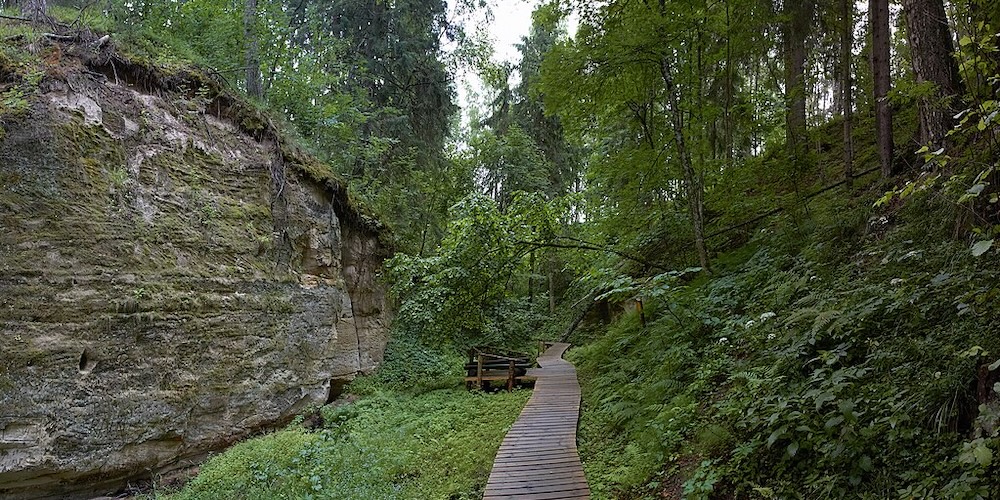
Hinn Canyon, Haanja Landscape Conservation Area – ©Vaido Otsar CC BY-SA 3.0 via Wikimedia Commons
Estonia contains over 1,560 natural lakes, with Lake Peipus, located on the border with Russia, and Võrtsjärv in central Estonia being the largest. The distribution of these lakes is uneven, with the largest concentrations found in southeastern and southern Estonia, while large areas of western and central Estonia are devoid of any lakes. In addition to natural lakes, Estonia has numerous artificial reservoirs, including the large Narva Reservoir on the eastern border. The country is also home to more than 7,000 rivers, streams, and canals, with only ten of them exceeding 100 kilometres (62 miles in length. The longest rivers in Estonia include the Võhandu at 162 kilometres and the Pärnu at 144 kilometres. The rivers are primarily fed by groundwater, rainfall, and snowmelt, with each source contributing approximately one-third of the annual runoff. Bogs and mires cover approximately 23.2% of Estonia’s land area, with individual bogs often forming extensive wetland complexes characterized by large peatlands interspersed with swamp forests, islands, lakes, and rivers.

Rõngu River, Lake Võrtsjär – ©Raul6 CC BY-SA 3.0 via Wikimedia Commons
Estonia’s climate that lies between continental and maritime influences, characterised as a humid continental climate. It is notably milder than that of other regions at the same latitude due to the moderating effects of the Atlantic Ocean and the North Atlantic current. The prevailing weather patterns in Estonia are significantly influenced by active cyclonic activity in the northern Atlantic, particularly from the Icelandic low. This results in strong winds, precipitation, and abrupt temperature fluctuations, especially during the autumn and winter months. The westerly winds carry moist maritime air far into the continental interior, leading to milder temperatures in winter and comparatively cooler conditions in summer. Coastal regions and islands generally enjoy a milder climate, with the Baltic Sea moderating temperatures, keeping coastal areas warmer in winter and cooler in summer. So, it has warm summers and fairly mild winters.
Primary local differences are caused by the Baltic Sea, which warms the coastal areas in winter, and cools them in the spring. The calculated mean temperature for the country’s territory ranges from 17.8 °C in July to −3.8 °C in February, with the annual average being 6.4 °C. The highest recorded temperature is 35.6 °C and the lowest is -43.5 °C. The annual average precipitation 26 inches. Snow cover varies significantly on different years. Prevailing winds are westerly, southwesterly, and southerly, the average annual wind speed varies, being lightest inland and the heaviest on the west coast. Seasonal differences in Estonia are also extreme in day length. For example, the longest day lasts up to 18 hours and 40 minutes in Tallinn and 18 hours and 10 minutes in Võru, while the shortest day is about 6 hours and 2 minutes in Tallinn and 6 hours and 39 minutes in Valga. The phenomenon of “white nights” occurs from early May to late July, during which the sun remains visible for extended periods. Snow cover varies significantly across the country, lasting on average between 75 and 135 days per year, with the least amount found on the western coast of Saaremaa and the most in the Haanja and Pandivere Upland.
Birding Estonia
Estonia is recognised as one of the most biodiverse regions in Europe, particularly for its size and latitude. The country boasts a diverse array of climatic and soil conditions, as well as an abundance of both marine and freshwater ecosystems. This rich biodiversity allows for the survival of many species that have become extinct in most other European nations. Protected areas cover 19.4% of Estonian land and 23% of its total area together with territorial sea. The country is home to nearly 4,000 protected natural objects, which encompass six national parks, 231 nature conservation areas, and 154 landscape reserves.
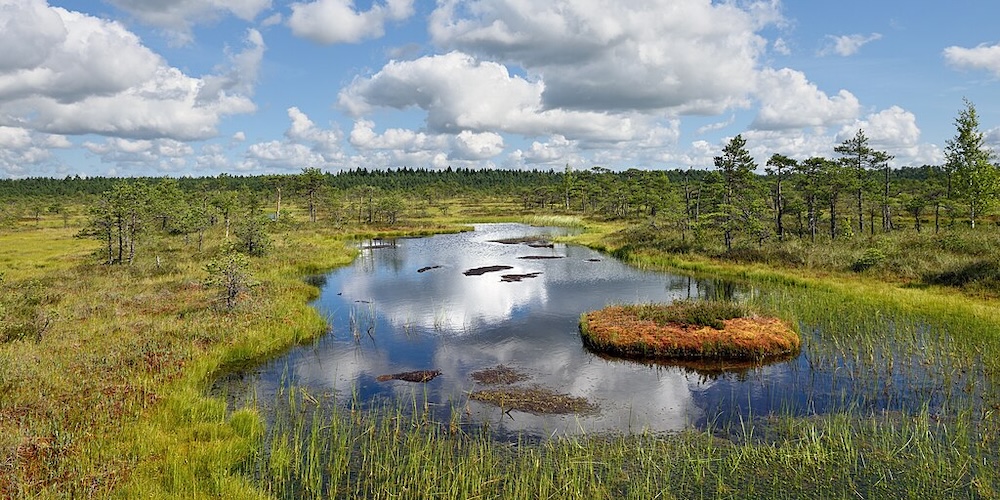
Endla Nature Reserve – ©Cayambe CC BY-SA 4.0 via Wikimedia Commons
Estonia lies on the northern border of the temperate broadleaf forest biomes. Phytogeographically, Estonia is shared between the Central European and Eastern European provinces of the Circumboreal Region within the Boreal Kingdom and belongs to the ecoregion of Sarmatic mixed forests. Estonian fauna is characterised by a significant presence of aquatic, riparian, forest, and open-field species. The country is home to 64 recorded mammal species, 11 amphibians, and 5 reptiles. Large mammals include the grey wolf, lynx, brown bear, red fox, badger, wild boar, moose, roe deer, beaver, otter, grey seal, and ringed seal. Notably, Estonia has successfully maintained a population of European minks on its islands through decades-long conservation programs, countering the encroachment of American minks. The critically endangered European mink has been successfully reintroduced on Hiiumaa, while the rare Siberian flying squirrel thrives in eastern Estonia. Furthermore, red deer, previously extirpated, have been successfully reintroduced. In the early 21st century, a population of European jackals was confirmed in western Estonia, expanding their range significantly. Introduced mammals include sika deer, fallow deer, raccoon dog, muskrat, and American mink.
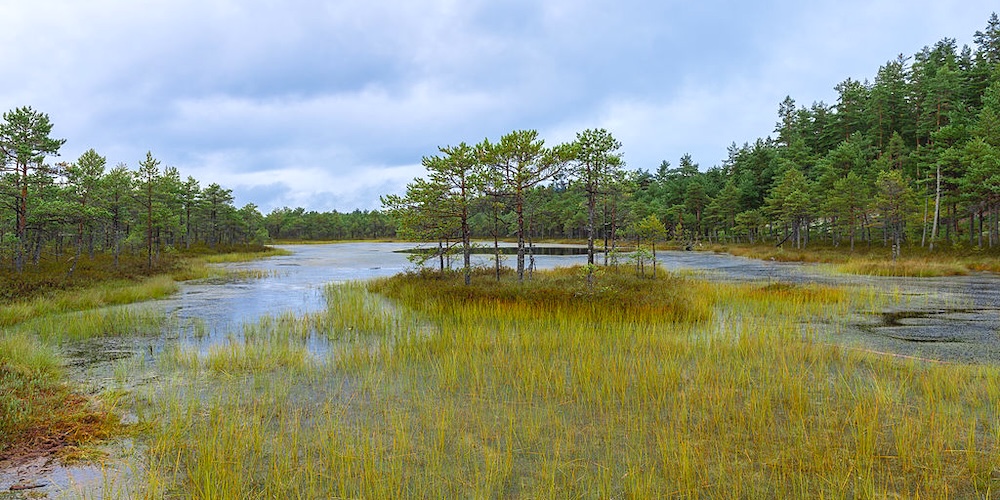
Meenikunno Nature Reserve – ©Abrget47j CC BY-SA 3.0 via Wikimedia Commons
Estonia’s natural landscape features unique flora, including endemic species such as the Saaremaa yellow rattle. Forest cover 48% of Estonia’s land area, supporting a wide range of plant species. Among these, 87 native and over 500 introduced tree and bush species have been identified, with the most common trees being pine (41%), birch (28%), and spruce (23%).
Estonia is located on the migration route for millions of passerines flying through central Estonia as well as over 50 million waterfowl and shorebirds flying along the north-western coast, holding the European record for the highest number of migrating species observed. Estonia has recorded over 400 bird species, around 225 of which are breeding birds. Around 100 species are mere vagrants. Because of a favourable geographical position in the East Atlantic flyway, millions of birds pass through Estonia in spring and autumn. Along the northern coast an impressive migration of waterfowl and shorebirds takes place during the autumn. At the same time, millions of passerine birds are flying along the coasts of Lake Peipsi and West Estonia. Up to 30,000 common cranes also use Estonia as a resting ground during their autumn migration.
In the spring, thousands of diving ducks, long-tailed ducks, scaup, common scoter, velvet scoter, and black-throated divers are concentrated in Riga Bay and Vainameri. As many as 100,000 Barnacle Geese may use West Estonia as a stopover during the spring migration. Estonia is also a very important spring staging area for Bewick’s Swan. During moult migration in July and August, up to 200,000 Common Scoter pass through Estonia.
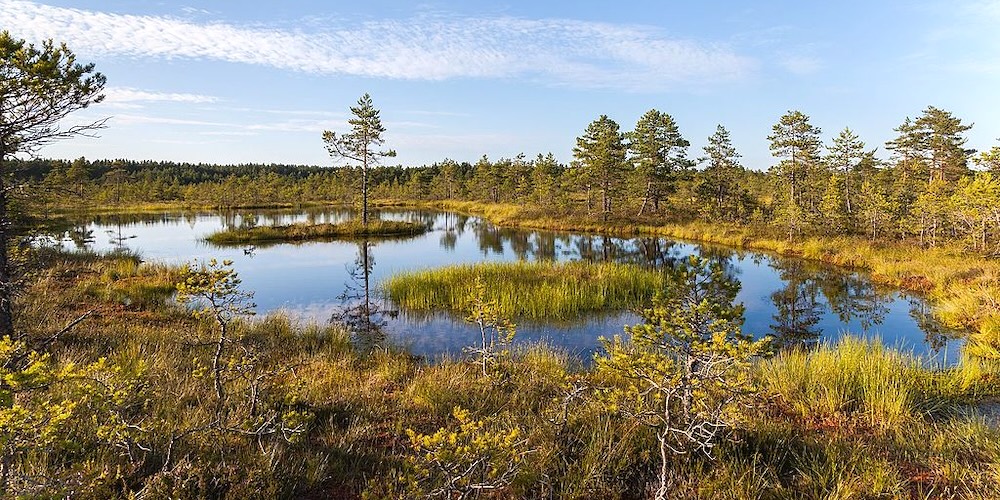
Viru bog, Lahemaa National Park – ©Diego Delso CC BY-SA 3.0 via Wikimedia Commons
Besides the excellent possibilities of watching the bird migration, Estonia also has many localities with rich breeding faunas. At some of these localities you can watch breeding birds in summer and migrating birds in spring and autumn.
(Much of the foregoing birding section was extracted from Bird-watching Localities in Estonia, with permission from Aivar Leito).
-
Number of bird species: 404
(As at April 2025)National Bird: Barn Swallow Hirundo rustica
-
Avibase
PDF ChecklistThis checklist includes all bird species found in Estonia , based on the best information available at this time. It is based on a wide variety of sources that I collated over many years. I am pleased to offer these checklists as a service to birdwatchers. If you find any error, please do not hesitate to report them. -
BirdLife Estonia (Estonian Ornithological Society)
ChecklistAltogether, 388 species of apparently wild state or released species which have established self-supporting breeding populations in Estonia or in neighbouring countries (i.e. categories A-C) have been recorded in Estonia by 31.03.2018. -
E-Bird
PDF ChecklistThis checklist is generated with data from eBird (ebird.org), a global database of bird sightings from birders like you. If you enjoy this checklist, please consider contributing your sightings to eBird. It is 100% free to take part, and your observations will help support birders, researchers, and conservationists worldwide. -
Wikipedia
Annotated ListThis is a list of the bird species recorded in Estonia. The avifauna of Estonia include a total of 404 species.
-
Birding Estonia
| By Uku Paal & Margus Ots | Eesti Loodusfoto | 2020 | Edition 2 | Paperback | 176 pages | ISBN: 9789949460311 Buy this book from NHBS.com -
Birds of Estonia
| (Status, Distribution and Numbers) | Edited by Eerik Leibak, Vilju Lillileht & Heinrich Veromann | Estonian Ornithological Society | 1994 | Hardback | 287 pages, 2 maps | Out of Print | ISBN: 9789985500316 Buy this book from NHBS.com -
Birds of Europe, North Africa, and the Middle East
| Photographic Guide | By Frédéric Jiguet & Aurélien Audevard | PUP | 2017 | Paperback | 447 pages, 2200 colour photos, colour distribution maps | ISBN: 9780691172439 Buy this book from NHBS.com -
Collins Bird Guide
| By Lars Svensson | Harper Collins | Edition 3 | 2023 | Paperback | 478 pages, 4000+ colour illustrations, 700 colour distribution maps | ISBN: 9780008547462 Buy this book from NHBS.com -
Finding Birds in Estonia
| By Dave Gosney | Easy Birder | 2011 | DVD | Runtime 85 Minutes | ISBN: 9781907316302 Buy this book from NHBS.com -
Finding Birds in Estonia
| By Dave Gosney | Easy Birder | 2011 | Paperback | 36 Pages, B&W Maps | ISBN: 9781907316296 Buy this book from NHBS.com

Collins Bird Guide
AndroidThe Collins Bird Guide App provides everything you need to identify a species quickly and learn about it thoroughly.
Collins Bird Guide
Apple iOS |Collins Bird Guide 4+ A field guide to Europe NatureGuides Ltd. Designed for iPadUseful Information-
Conservation
The tradition of nature conservation in Estonia is over 90 years old. Our first nature reserve (that of Vaika, the present Vilsandi State Nature Reserve) was founded as early as 1910. Our first nature conservation law was passed in 1935. The one in force at the present time dates back to 1957. To date Estonia has one national park, 4 state nature reserves and 29 various partial reserves, all of these covering 5% of its territory. Other protected objects include 37 landscape elements, 47 parks, 3 dendroparks, 11 orchards and a number of old fruit-trees, 222 erratic boulders and boulder-strewn areas, 330 old trees and copses, 59 plant and 198 animal species. From: An Ornithological Journey through the Estonia S.S.R. Guide to an excursion for the participants of the 18th International Ornithological Congress (Moscow, August 1982). Tallinn Valgus press. 1981. Edited by E.Kumari. Introduction. Pp.3-4.
Observatories-
Haeska Birdwatching Tower
Observatory WebsiteSatellite ViewThe Haeska birdwatching tower on the north shore of Matsalu Bay is one of the best bird observation towers in Europe. The coastal meadows and shallow bay are a popular spot among migratory birds and therefore a splendid spot for birdwatching. -
Kabli Bird Observatory
Observatory WebsiteSatellite ViewHundreds of birds, which have been marked in Kabli Bird Station, have been found again. Most of the recoveries come from the bird stations around of Baltic Sea. These recoveries give the opportunity to calculate the migration speed and identify migration routs. With the cooperation of other bird stations is possible to follow the bird migration both in the time and space -
Sörve Bird Observatory
Observatory WebsiteSatellite View -
Vaibla Bird Obseravtory
Observatory WebsiteSatellite ViewFounded in 1987, Vaibla Bird Observatory is the only inland bird station in Estonia at the present time. It is run entirely by volunteers organized as a non-profit organization.
Organisations-
Eagle Club
WebsiteThe Eagle Club is a non-governmental organisation whose members have studied, observed and protected eagles for decades. Currently, the Eagle Club comprises 25 members who occupy themselves with research on eagles and black stork and their protection in Estonia. They include both specialists in ornithology and nature conservation, foresters, and also enthusiasts of nature and eagles protection… -
EstBirding
WebsiteEstonian Birding/Twitching Club run by keen Estonian birders. Our main purpose is to give up-to-date information on local rarities and other bird related news. Plus you can find some trip reports and articles. Our gallery has 1000+ photos of Estonian and world birds, local rarities, abberrant birds/hybrids, plus some material of our birding community in action… -
Estonian Fund for Nature
WebsiteThe mission of ELF (Eestimaa Looduse Fond - Estonian Fund for Nature) is to preserve the rich natural diversity in Estonia and the world through active cooperation with individuals, business enterprises, organizations and state institutions -
Estonian Ornithological Society
WebsiteBaer House, Vesti Str. 4, 50002 Tartu.+372 7 422195; jaanus@linnu.tartu.ee Now some parts in English -
Looduskalender
WebsiteEstonian nature protecting project. Looduskalender offers some live streams: Small Bird Feeder Camera, Lesser Spotted Eagle Camera, Black Stork Camera, White-tailed Eagle Nest Camera, Eagle Winter Webcam, Grey Seal Webcam etc. (not all of them are open; it´s changing during the year). -
Läänemaa Bird Club
WebsiteRecent observations from Western Estonia, as well as some materials and links, local birdlists and maps are available. Homepage is mostly in Estonian, but there are pages for English-speaking reader… -
Viron Lintuseura
WebsiteEstonian Birding Society (a finnish non-profit NGO, since 1997) seeks to further the protection and knowledge of birds and bird areas in Estonia; upholds co-operation between Finnish and Estonian bird watchers and promotes birding as a hobby in Estonia. We collect bird-observations in collaboration with Tartu University eElurikkus
Reserves-
Protected areas of Estonia
InformationSatellite ViewInteractive links to National Parks, Nature Conservation areas, Strict Nature reserbves etc. -
BR West Estonian Archipelago
InformationSatellite ViewThe West Estonian Islands Biosphere Reserve -
Estonia's IBAs
InformationSatellite ViewThere are 64 IBAs in Estonia -
NP Karula
InformationSatellite ViewIt is the smallest national park in Estonia. The flora of the national park is rich, and includes several species red-listed in Estonia such as the Baltic orchid, mezereon and the daisyleaf grape fern; the latter is only found in three locations in Estonia and Karula is one of them. The fauna also incorporates unusual and threatened species, such as the pond bat, the lesser spotted eagle and the black stork. Mammals like elk, lynx and polecat are common. -
NP Lahemaa
InformationSatellite ViewProtection, conservation and interpretation of typical nature and cultural heritage for Northern Estonia, included ecosystems, biodiversity, landscapes, etnoculture and sustainable nature use… -
NP NR Matsalu
InformationSatellite ViewIt is made up of Matsalu Bay, the Kasari River delta, the village of Matsalu and surrounding areas. It is a home for a number of endangered species, many of which are listed in the Estonian IUCN Red List, including the white-tailed eagle. -
NP Vilsandi
InformationSatellite ViewIt includes part of the island of Vilsandi, a number of smaller islands, adjacent parts of western Saaremaa and the Harilaid peninsula on Saaremaa, all in Kihelkonna Parish and Lääne-Saare Parish. It is a highly sensitive ecosystem due to the use of the area as stop-over by many migratory birds, like barnacle geese and Steller's eider, and as a breeding and nesting ground for over 247 species of birds, of which the most common is the eider duck. One third of all protected plant species in Estonia can also be found in the national park. -
NP WII Soomaa
InformationSatellite ViewSoomaa (land of bogs) protects 390 km², and is a Ramsar site of protected wetlands. The site regularly supports more than 1% of the individuals in relevant populations of Cygnus columbianus and Grus grus, and the composition of bird species in these bogs, especially Kuresoo, is one of the most representative in Estonia. Species recorded include Aquila chrysaetos, Numenius phaeopus (more than 100 pairs), Pluvialis apricaria (ca 150 pairs) Calidris alpina schinzii, Falco columbarius, Lagopus lagopus, and Circus pygargus. During the autumn migration, it is a stopover and roosting site for Grus grus (approximately 1,000) and Cygnus columbianus (approximately 500), and during spring migration (approximately 2,000) for C. columbianus. Crex crex is still numerous on floodplain meadows (50-100 pairs). It is an important spawning ground for the fish Esox lucius. -
NR Agusalu
InformationSatellite ViewThe nature reserve encompasses a portion of a large area of wetlands, and the landscape is dominated by bogs; however it is also the location of the only system of continental sand dunes in Estonia, overgrown with rare old-growth forest. The area is home to a number of rare or protected species. From the fauna, grey wolf and Eurasian lynx can be mentioned, as well as several birds - it is the most important nesting area in Estonia for the common greenshank and home to both white-tailed eagle and golden eagle. -
NR Muraka
InformationSatellite ViewThe nature reserve is characterised by its wetlands; several large bogs are surrounded by mires, swamps, fens and rivulets. In addition, there are also areas of unspoilt forest. The nature reserve is one of few remaining wilderness areas in north-east Estonia. -
NR Nigula
InformationSatellite ViewOne of the oldest and best researched bog and forest ecosystem protection areas is known as a bog reference site all across Europe. The Nature Reserve was established in 1957. Since 1979 it is a bird area of international importance. -
NR WII Alam-Pedja
InformationSatellite ViewAlam-Pedja Nature Reserve is the largest nature reserve in Estonia. It is a vast wilderness area which covers 342 km2 (85,000 acres) and consists of a complex of 5 large bogs separated by unregulated rivers, their floodplains, and extensive forests. The only types of lakes found in the nature reserve are oxbow lakes and more than 2000 bog pools. Alam-Pedja is the most important breeding area for great snipe in Estonia and the Baltic countries. The greater spotted eagle is another threatened bird species breeding in the area -
Nature Reserves in Estonia
InformationSatellite ViewProtected areas in Estonia cover 485,198 hectares, that is 10.73% of the national territory (water areas not included) -
Wetlands
InformationSatellite ViewThe convention entered into force in Estonia on 29 July 1994. Estonia currently has 17 sites designated as Wetlands of International Importance (Ramsar Sites), with a surface area of 304,778 hectares.
Sightings, News & Forums-
eBird
SightingseBirding This Month
Guides & Tour Operators-
Baltic Nature Tours
Tour OperatorSpecialized tours for specific bird species and bird-watching sites of national and international importance, particularly during migration periods. -
BirdFinders
Tour OperatorEstonia’s resident birds include Western Capercaillie, Hazel Grouse, White-tailed Eagle, Eurasian Eagle-owl, Eurasian Pygmy-owl, Ural Owl, White-backed, Eurasian Three-toed, Black and Grey-headed Woodpeckers and Spotted Nutcracker. -
Birding Haapsalu
Local Tour OperatorBirding tours in Estonia -
Birds Wildlife & Nature
Tour OperatorIf you have not visited Estonia before then you may be in for a surprise. -
BirdwatrchingTrips
Tour OperatorEstonia Migration calling -
Boletas
Tour OperatorA 5-day fully-inclusive holiday in search flocks of Steller´s Eider and other wintering specialities of West-Estonia. -
Capture Estonia
Local Tour OperatorThis guided bird watching tour is a great introduction to Estonia’s birdlife and suitable for regular and serious birdwatchers, nature lovers or people who just want to have day tour outside of Tallinn -
Estonian Wildlife Tours
Local Tour OperatorCome to the (European) birds’ paradise – Estonia! -
HeatherLea
Tour OperatorA Baltic Birding Bonanza, superb Eastern breeding birds and thousands of Northern migrants! -
NaTourEst - Nature & Birdwatching Tours in Estonia
Local Tour OperatorEstonia, a small country on the shores of the Eastern Baltic Sea, is increasingly popular among birdwatchers, who flock in ever increasing numbers to watch spectacular arctic migration in spring and autumn. There is much more to offer, even in wintertime… -
NatureTrek
Tour OperatorEstonia - A Steller's Eider Special -
Oriole Birding
Tour OperatorOur Estonia Summer birding tour offers some of the most extraordinary birding opportunities in eastern Europe -
Swallow Birding
Tour OperatorEstonia – Baltic Spring Birding -
The Travelling Naturalist
Tour OperatorJoin us on a long-weekend in western Estonia to search for large flocks of Steller’s eider, among other winter specialities... -
Wildlife Travel
Tour OperatorA week on the Baltic, in search of owls, woodpe
Trip Reports-
2016 [06 June] - Ivan Nethercoat
PDF Report… a white-tailed eagle flew low toward us and kept on going toward a small group of greylag geese. It then dropped down onto one of the birds, standing on it for a few moments and then flying off with a young goose. -
2021 [08 August] - Frank van Groen
PDF ReportI made this individual trip to the Baltic states of Estonia and Latvia with my wife Inka. The trip was organised by the dutch travel agency SNP Natuurreizen. We used a almost new hired car (Toyota Yaris hybrid, 30km/L, distance travelled 2003 km), except for the city trip in Tallinn. During our stay the weather was fine, with almost no rain and moderate temperatures. -
2022 [03 March] - Michiel de Boer
ReportThe other reason to visit Estonia (apart from visiting a new country) was to find my last Owl of Europe and my number one wanted missing species of Europe: Ural Owl. Also, Ural Owl is quite likely there though March is a little bit early. -
2022 [04 April] - Mark Bonello
PDF ReportThe visit was timed to manage some of the early spring migration as well as to see the wintering birds. Our main targets included Black Grouse, Bohemian Waxwing, Ural Owl, Pygmy Owl, Cappercaille and Hazel Grouse. Unfortunately the latter two were flushed and not seen properly while for the rest we had particularly good views. It was an exceptionally good winter to observe hawk owls but our timing was late and no records of this species would be taken back home, as they had already left. -
2023 [02 February] - Sofia Broström
PDF ReportI visited Estonia in February 2023 with some friends - Ingrid Evaldsson, Mikael Qvarfordh and Markus Qvarfordh. Our primary target was to see overwintering Steller’s Eiders from Saaremaa, a mission that was accomplished on our first morning there. Despite the early season, we were also hoping to see some owls and woodpeckers both on Saaremaa (Vidumäe Nature Reserve) and on the mainland - mainly Soomaa National Park - but apart from a Middle Spotted Woodpecker (and lots of Great Spotted) we did not succeed on that front. -
2023 [06 June] - Jonathan Prochera -Sooma National Park and Tartu area
PDF Report...An adult white-tailed eagle and singing great read warbler at a map stop were it apart from a couple of hooded crows... -
2024 [03 March] - Jon Lehmberg
PDF Report...In many respects, this trip was very different from the ones we usually do, we being 6 Danish birders with an interest in mammals as well... -
2024 [03 March] - Nathaniel Dargue
PDF Report...We managed to see 79 species during our trip, all eBird checklists of what we saw and exactly where are featured in this trip report... -
2024 [05 May] - Erik Hirschfeld
PDF Report...This year I wanted to see how the migration was in late May. I also wanted to explore the Saaremaa side in Estonia to see if I could se any arrivals there of landbirds/raptors. As I was moving around I also decided to visit the east of Latvia to break o with some inland birding inbetween... -
2024 [06 June] - Ed Tooth
PDF Report...We planned an 8-day trip to Estonia, staying in two locations, one in south-eastern and one in south-western Estonia, to cover sites including Aardla Polder, Ilmatsalu Fishponds, Karevere Floodplain Meadows, Taevaskoja Gorge, the Estonian-Russian borderlands, Sooma National Park and Nigula Bog... -
2024 [07 July] - Jean Hugé
PDF Report...we spotted Hooded Crows and two Cranes standing in the pouring rain – just enough to give us a sense of nordic travel...
Places to Stay-
Algallika Guesthouse
AccommodationAlgallika guesthouse rooms are renovated in 2008 and 2014. Our rooms have big windows with sea, garden and fields view. Whole house is heated with geothermal energy... -
Puise Nina Farm
AccommodationBird-watching tower is suitable for nature lovers, family holiday, romantic evening, brainstorming sessions or spending otherwise good time together in a smaller campaign. -
Tuulingu Puhkemaja Holiday Cottage - Haeska village, Matsalu National Park
AccommodationIf you are fond of seaside places with a tender breeze, coastal meadows, sea birds and the sun that sets behind the cape and you wish to have a rest at such an idyllic place - well, you have opened the right page. Come and visit Matsalu National Park, where unique coastal meadows open to the sea have preserved up to now. In Haeska which is on the migration route of tens of thousands of birds you can observe the birds
Other Links-
Hirundo
WebsiteHirundo, the journal of the Estonian Ornithological Society, is issued twice a year. It publishes ornithological papers, comments and instructions, as well as EOS news. The journal is focused on original studies and discussion about Estonian birds, their numbers, biology and conservation.
Photographers & Artists
Fatbirder - linking birders worldwide...
Skip to content
